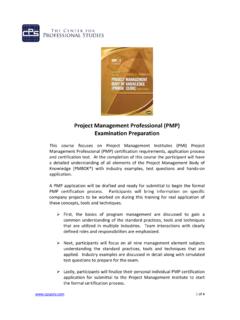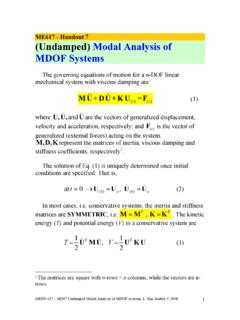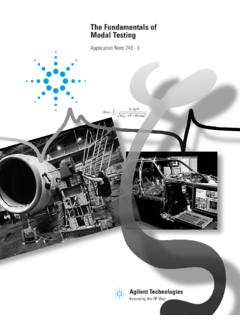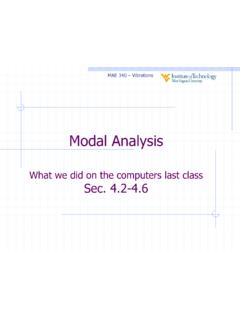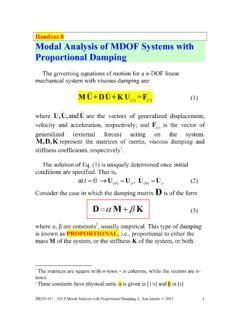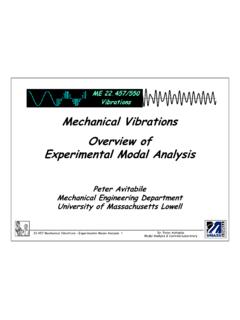Transcription of Advanced Modal Analysis - cpspoly.com
1 1 of 8 Advanced Modal Analysis This course focuses on additional test and Analysis tools beyond those presented in the Basic Modal Analysis course. Topics include operating data, multiple input multiple output testing, Advanced multiple reference Modal parameter estimation, structural dynamic modification using both Modal data and measured impedances, forced response simulation, and other topics related to Advanced manipulation of measured structural dynamic data. First, the basics of Basic Modal Analysis and applicable engineering fundamentals are discussed to gain a common understanding of the application and general principles are reviewed.
2 Next, participants will focus on further developing their skills beyond Basic Modal Analysis . Lastly, participants will be shown how to run the model and interpret output results on LMS software products. A thorough understanding of what these results mean and how to use them to improve the product design will be discussed. 2 of 8 Course Syllabus I IDENTIFYING INFORMATION Course: Advanced Modal Analysis Prerequisite: Experimental Modal Analysis Time Frame: 40 total contact hours Instructor: Dr. Peter Avitabile Director of the Modal Analysis and Controls Laboratory BS in Mechanical Engineering MS in Mechanical Engineering PhD in Mechanical Engineering 25 years at UMASS Lowell Professor Mechanical Engineering 10 years industrial experience in structural dynamics, modeling and design E-mail: II REFERENCE MATERIALS 1.
3 The Fundamentals of Signal Analysis (Hewlett Packard App Note 243) 2. Fundamentals of Modal Analysis (Hewlett Packard App Note 243-3) 3. Experimental Modal Analysis - A Simple Non-Mathematical Overview Modal Space articles originally published in Experimental Techniques III COURSE GOALS AND OBJECTIVES 1. Understand the steps in the development of an experimental model 2. Understand the considerations for the test beyond a basic simplistic test 3. Understand SDOF and MDOF models and Modal space concepts 4. Understand the need for windowing and its effects 5. Know and understand the basic and Advanced measurements needed 6. Understand and be able to apply impact and shaker excitation techniques 7.
4 Understand multiple input multiple output employed in Modal testing 8. Understand tools used for identification of modes 9. Understand and be able to validate experimental Modal models 10. Understand the structural dynamic modification and modeling approaches utilizing reduced order models, Modal models and frequency response 11. Understand the collection of operating data and extraction methods for development of a Modal model from output only system measurements 3 of 8 12. Understand the forced response simulation procedures using Modal data 13. Understand how to apply Advanced linear algebra methodologies in the application for solving Advanced structural dynamic modeling 14.
5 Understand the basic approaches for the correlation of measured data with analytical models (such as a finite element model) 4 of 8 IV METHODOLOGY This course is an introduction to Advanced Modal Analysis theory and techniques that are used to characterize the dynamic characteristics of structures. Each module will introduce new material that the student will be allowed to experience for himself with the associated exercises. Lectures Each detailed subject will be presented in a lecture format outlining the theory and standardized accepted methodology. A printed copy of the lecture material will be provided for the student s personal in-class use and as a reference material.
6 Specific Industry Examples Real life examples will be covered that explain the application of the theory to various industries such as automotive, aerospace, home appliance. This will give the students a clear understanding of how and why these techniques are utilized in different industries and the value they add to noise and vibration refinement. In-Class Assignments The student will conduct several hands-on exercises to reinforce the theoretical concepts and to perform Advanced analyses. These exercises will increase in complexity as the students further develop their skills in understanding Modal theory and practice.
7 Many different data sets are collected as a class and then individual groups are given specific tasks/approaches for the reduction of data; different groups are given different subsets of data to manipulate for operating data collected. The students will present their work to the group for review and discussion. Other more structured lab exercises are also given as individual assignments for the application of SDM, system modeling, forced response simulation, etc. 5 of 8 V COURSE OUTLINE & ASSIGNMENTS Module 1 Overview of Structural Dynamic Modeling Techniques Modal Analysis and Structural Dynamics Analytical Modal Analysis and Finite Element Models Experimental Modal Analysis and Experimental Modal Reduction Frequency Response Functions (FRFs)
8 And Mode Shapes from FRFs Correlation and Updating Models Overview of Advanced Applications of Structural Dynamic data Module 2 Review of Basic Modal Analysis Theory and Related Topics Different Mathematical Model Formulations SDOF and MDOF Theory Overview Frequency Response Functions Linear Algebra Concepts for Structural Dynamic Applications Module 3 Review of Basic Measurement Definitions Linear Spectra and Power Spectra Derived Relationships and Effects of Noise Estimators H1, H2, Hv Auto Power and Cross Power Spectrum; Frequency Response Function; Coherence Module 4 Review of Basic Impact and Single Shaker Excitation Overview Basic Impact Testing Procedures Review Multiple Reference Impact Test Overview Basic Shaker Testing Approaches & common excitation signals utilized Module 5 Multiple Input Multiple Output Shaker Testing Multiple Input Shaker Testing Principal Component Analysis Multiple and Partial Coherence SISO vs.
9 MIMO Module 6 Mode Indicator Techniques Review of Identification Functions Typically Employed (such as Mode Indicator Function, Multivariate Mode Indicator Function, Complex Mode Indicator Function, Stability Diagram and Poly MAX) 6 of 8 Module 7 Basic Modal Parameter Estimation Parameter Estimation Concepts and Parameter Extraction Considerations Classification of Modes; Time and Frequency Domain Representations Different Forms of the Same Equation; Why Have Different Methods Modal Parameter Estimation Concepts and Extraction Considerations Mode Determination Tools; Model Order; Stability Diagram Modal Extraction Methods SDOF Modal Parameter Estimation MDOF Modal Parameter Estimation Modal Parameter Estimation Considerations Module 8 Modal Parameter Estimation Guidelines and Practical Considerations Basic Curve Fitting; Considering Complicated Structures; Curve Fitting Guidelines Historical Perspective of Modal Parameter Estimation Case study of a very complicated aerospace structure with methodology used to decipher MIMO test results to obtain useful Modal parameters Module 9 Model Validation Basic and Advanced Tools Animation Modal Assurance Criteria FRF Synthesis Modal Participation.
10 Mode Complexity Mode Phase Colinearity / Mean Phase Deviation Amplitude Weighted Assessment Function with application to Rib Stiffened Plate Extended Amplitude Weighted Assessment Function Module 10 Test Reference Identification Procedure with Applications Identification of Reference Locations using Singular Valued Decomposition Practical Development of the Test Reference Identification Procedure using SVD Rib Stiffened Plate Example; Repeated Root Plate Example; Composite Plate Pseudo-Repeated Root Example; Composite Fin Plate Pseudo-Repeated Root Example Application of TRIP on Large Chiller Unit Module 11 Additional Topics in Modal Analysis Advanced Formulations Re-visit the Input-Output Frequency Domain Formulation of Dynamic Response - Develop the Forced Response Simulation Approach - Develop Operating Data Approach Output Only Systems - Develop the Force Estimation from Operating Data 7 of 8 Module 12 Operating Deflection Shapes Characterization: Time or Frequency Domain ODS: Time Domain ODS: Frequency Domain, Linear Spectrums ODS: Frequency Domain, Transmissibility ODS: Frequency Domain, Cross Spectrum ODS.
